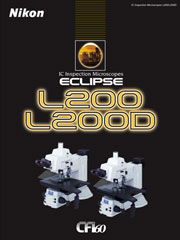Nikon Eclipse L200 Series IC Inspection Microscopes
Nikon Updated: 2007-06-19Incorporating CFI60 optics for flawless inspection of 200mm wafers and masks.
Combined with Nikon’s superior CFI60 LU/L optical system and an extraordinary new illumination system, this microscope provides images with greater contrast, high resolving power and darkfield images three times brighter than before. Used independently, or in combination with wafer loaders, the L200 series performs exceptionally precise optical inspection of wafers, photo masks, reticles and other substrates.
CFI60 Optical System
Provide outstandingly clear, sharp images with longer working distances, high numerical aperture (NA) and minimal flare. Signal to background ratios during darkfield observations are three times better than before to provide outstanding high contrast images ideal for high precision observations.
Vibration Isolation
Applying computer-aided engineering (CAE), Nikon increased the rigidity of the L200 series dramatically, making these microscopes three times less susceptible to floor vibrations when compared with conventional equipment. This, in turn, reduces the chance of unwanted blur or image shifts even during high magnification observations. While this superior design increases stability, it also results in a smaller footprint.
Contamination Safeguards
The bodies of these microscopes are finished with electrostatic discharge coatings to prevent foreign particles from adhering to the microscope. Furthermore, the motorized nosepiece uses a shielded center motor that traps foreign particles inside, preventing them from falling onto the sample.
Improved DIC microscopy
Nikon's CFI LU Plan objectives allow the use of multiple observation techniques, including brightfield, darkfield, and Nomarski DIC using a single objective. For DIC, simply insert a single Nomarski prism into the nosepiece that works for all magnification ranges.
SEMI S2-0200, S8-0600 Compliant Design
Incorporating a SEMI-compliant design, controls and knobs are positioned low and close to the operator while the eyepoint is set at the ideal height for comfortable operation. With the controls located comfortably in the microscope base, hand movement is minimal, allowing concentration on the inspection process. The eyepiece is moved closer to the operator so that he or she can assume a more erect sitting posture. This also positions the operator farther from the stage to provide a more ergonomic and safe viewing position.
Tilting Eyepiece Tube
The eyepiece tube is of the trinocular tilting type, allowing continuous adjustment of the tilt angle from 0° to 30° for viewing at the optimum eyepoint level. The eyepiece also features an ultra-widefield design and has an F.O.V. of 25mm.
Fixed-Position X-Y Fine-Movement Controls
The X-Y fine-movement controls remain in the same position, close to the front, for a comfortable viewing posture regardless of the stage position. In addition, these controls, plus the focus knob, are located close to each other so you can operate both with one hand.
Motorized Nosepiece with Software Control
The Eclipse L200A features a built-in motorized nosepiece, which includes a slot for DIC attachment. In addition to a mechanical click stop, this nosepiece is controlled by software to stop precisely at each objective position. The improved accuracy also dramatically increases the durability of the nosepiece. Moreover, when the nosepiece is rotated, the illumination is cut momentarily to protect the operator's eyes.
3 Models to Choose From
L200: Offers 200mm wafer and mask inspection capabilities for reflected light defect identification.
L200A: Automated version of the L200. Frequently used operations such as aperture control, focusing, brightfield/darkfield changeover, nosepiece rotation, lamp intensity control, and DIC settings are all motorized and can be controlled by the remote controller or a PC.
L200D: The most advanced model. Adds transmitted light capabilities which is ideal for LCD and mask inspection.
Eclipse L200 Series
Related Manuals
Nikon Eclipse L300 Series FPD/LSI Inspection Microscopes
Nikon NWL-860 IC Inspection Wafer Loader
Nikon Eclipse LV150 Series Industrial Microscopes
Nikon NWL-641 IC Inspection Wafer Loader
Nikon Epiphot 200 Inverted Metallograph Microscopes
Nikon MM400/800 Industrial Measuring Microscopes
Nikon Epiphot 300 Inverted Metallograph Microscopes
Nikon Eclipse C1si Confocal Microscope System
Nikon Eclipse C1 Plus Confocal Microscope System
Nikon Eclipse MA100 Inverted Metallograph Microscope
Nikon LiveScan SFC Swept Field Confocal Microscope
Nikon Eclipse LV100D Upright Industrial Microscope
